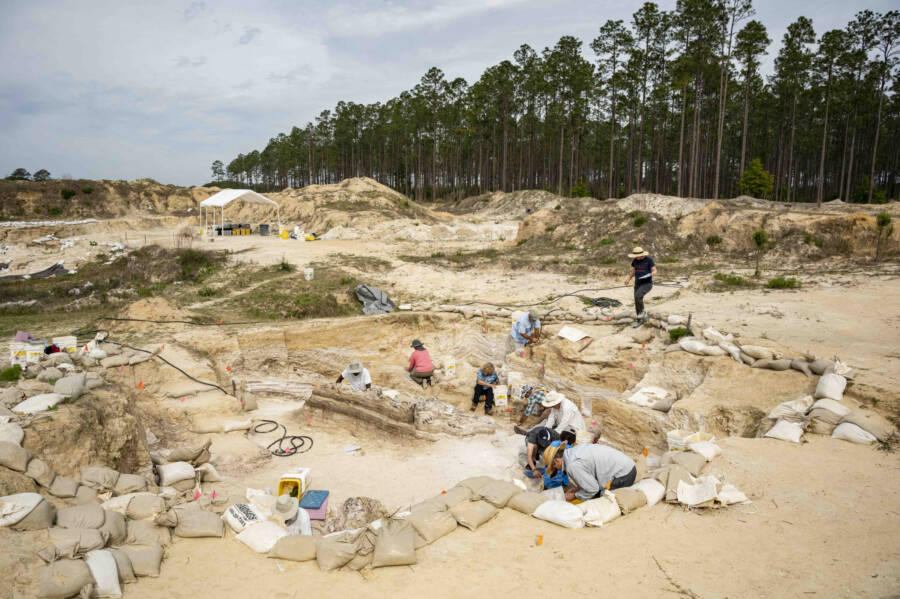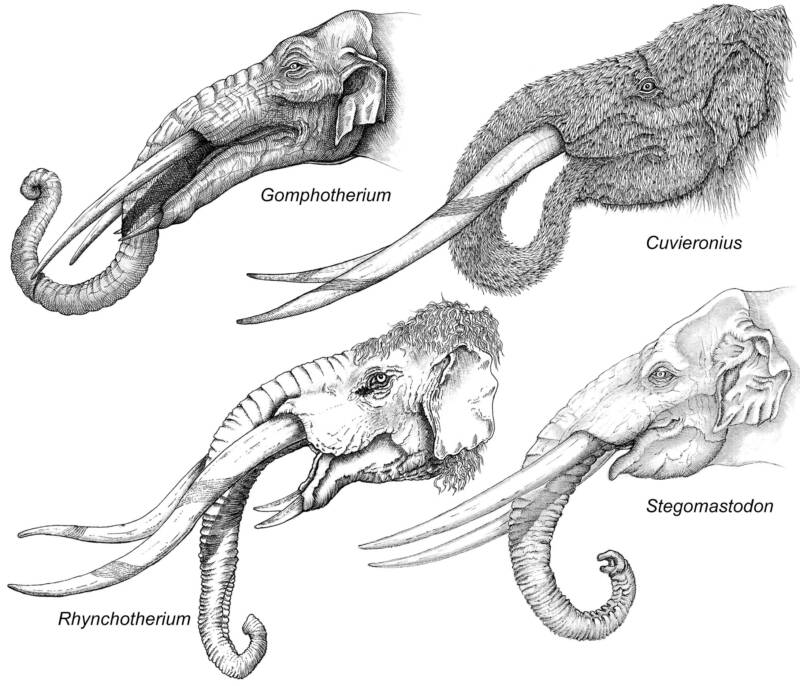The bones belong to the gomphothere, a distant relative of modern elephants that roamed the earth for millions of years before being hunted to extinction 12,000 years ago.

Kristen Grace/Florida MuseumThe skull of the adult gompothere in the foreground.
Five and a half million years ago, Earth was populated with an elephant relative known as a gomphothere. These prehistoric beasts have been extinct for some time now, but they are still offering paleontologists a unique view of the past. Most recently, this came in the form of a large “elephant graveyard” in a dried-up river in North Florida.
Per a statement from the Florida Museum, scientists and volunteers began unearthing gomphotheres at the Montbrook Fossil Dig in the spring of 2022. Montbrook had revealed isolated gomphothere bones before, but one volunteer noticed something unique buried in the earth.
“I started coming upon one after another of toe and ankle bones,” said Dean Warner, a retired chemistry teacher and Montbrook volunteer. “As I continued to dig, what turned out to be the ulna and radius started to be uncovered. We all knew that something special had been found.”
As the team worked, they realized they were looking at a near-complete gomphothere skeleton.
“This is a once-in-a-lifetime find,” said Jonathan Bloch, curator of vertebrate paleontology at the Florida Museum of Natural History. “It’s the most complete gomphothere skeleton from this time period in Florida and among the best in North America.”
But as they continued to dig, they had another realization: there wasn’t just one gomphothere skeleton buried in the dirt; there were several. Soon enough, they had unearthed the skeleton of one adult gomphothere and at least seven juveniles.
Although the specimens must be fully excavated before their size can be accurately determined, Bloch estimated that the adult stood eight feet tall at the shoulders. Its skull, tusks included, measures more than nine feet in length.
“It was very exciting because this gave us an opportunity to not only see what an adult [gomphothere] would have looked like, but also to very carefully document each and every bone in its skeleton,” Bloch told Live Science. “That’s exciting from a scientific perspective if you’re trying to understand the anatomy of these animals and something about their biology and evolution.”
Curiously, the various gomphotheres buried at the site likely did not all die at once, either. Instead, researchers believe they likely came from different herds at various points in time. This means they all died in the same spot, for some reason, or were transported to this spot and laid to rest. As Bloch explained, “They were actually in place as if the animal had just laid down and died.”
Rachel Narducci, the collection manager of vertebrate paleontology at the Florida Museum, said she also feels the gomphotheres were successively deposited or transported to the area.
“Modern elephants travel in herds and can be very protective of their young, but I don’t think this was a situation in which they all died at once,” she said. “It seems like members of one or multiple herds got stuck in this one spot at different times.”
Researchers believe the adult gomphothere drowned at this location, whereas the water likely swept up the others after dying and then became wedged in a bend in the river. This pile-up would have had a similar effect to a logjam, Bloch noted, referring to it as a “bonejam.”

Kristen Grace/Florida MuseumThe Montbrook Dig Site came to researchers’ attention in 2015.
“We’ve never seen anything like this at Montbrook,” Narducci said. “Usually, we find just one part of a skeleton at this site. The gomphotheres must have been buried quickly, or they may have been caught in a curve of the river where the flow was reduced.”
The Montbrook site first came to researchers’ attention in 2015, when local Eddie Hodge contacted the Florida Museum about fossils found on his property. In the eight years since, Montbrook has proven invaluable to researchers hoping to understand more about Florida’s prehistoric life.
Although Montbrook is located 30 miles inland from the Gulf of Mexico, the region was closer to the sea during the late Miocene period, when the gomphotheres roamed. The result is a strange hodgepodge of fossils accumulated together in one region, including salt and freshwater fish, camels, rhinoceroses, llamas, turtles, alligators, shrimp, and even sharks.
This prehistoric collection has yielded several remarkable discoveries before, as well. Over the years, paleontologists working at Montbrook have discovered the oldest deer in North America, a new species of extinct heron, and the oldest known skull of a smilodontine saber-toothed cat.

Pedro Toledo, CC BYDepictions of various elephant relatives including the gomphothere, listed as Rhynchotherium.
That said, these remains are rarely found intact. Most often, they had been transported by running water and lost along the way. The fact that they found not just one, but several gomphothere skeletons at Montbrook is nothing short of remarkable.
“A fossil site in southern California is the only other place in the U.S. that has produced a large sample of Rhynchotherium juveniles and adults,” Bloch said. “We’re already learning so much about the anatomy and biology of this group that we didn’t know before, including new facts about the shape of the skull and tusks.”
Bloch and his team plan to assemble the fossils from the adult gomphothere and display them to the public alongside the mammoth and mastodon skeletons at the Florida Museum of Natural History.
After learning about this groundbreaking new discovery, read about a less-friendly prehistoric creature, the 10-foot-tall, 1000 pound terror bird. Or, read about the 36-million-year-old “sea monster” fossil found in the Peruvian desert.





